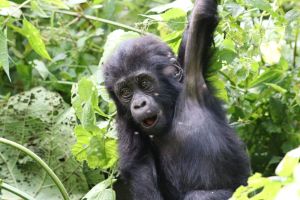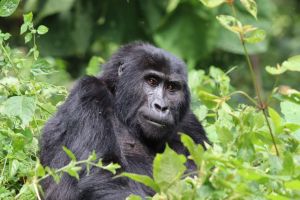Bwindi Impenetrable National Park
East Africa > Uganda > Bwindi Impenetrable National Park
Français | Português | Español | Bahasa Indonesia | Melayu
Summary
- Eastern chimpanzees (Pan troglodytes schweinfurthii) & mountain gorillas (Gorilla beringei beringei) are present in Bwindi Impenetrable National Park.
- It has been estimated that 459 gorillas occur in the site; the chimpanzee population size is unknown.
- The gorilla population trend is increasing.
- The site has a total size of 321 km².
- Key threats to great apes are linked to high human presence, which poses some risk of disturbance and disease transmission.
- Conservation activities have focused on ecotourism programs and regularly monitoring the health of habituated gorillas.
- The park is a UNESCO Natural World Heritage Site.
Site characteristics
Bwindi Impenetrable National Park is located in southwestern Uganda, on the edge of the Albertine Rift Valley. The area is one of Uganda's oldest and most biologically diverse rainforests, which dates back over 25,000 years (Uganda Wildlife Authority). Encompassing a series of steep ridges and valleys, Bwindi is the source of five major rivers, which flow into Lake Edward. The park is famous for being home to almost half of the world's mountain gorilla population (Uganda Wildlife Authority). The site is a designated Important Bird Area, with 347 bird species documented in the forest, including 23 endemic species to the Albertine Rift (BirdLife International 2020). Bwindi was gazetted as a National Park in 1991 and declared a (UNESCO Natural World Heritage Site) in 1994.
Table 1. Basic site information for Bwindi Impenetrable National Park
| Species | 'Gorilla beringei beringei |
| Area | 321 km² |
| Coordinates | Lat: -1.017254 , Lon: 29.671192 |
| Type of site | Protected area (National Park) |
| Habitat types | Subtropical/tropical montane forest, Subtropical/tropical moist lowland forest |
| Type of governance |
IUCN habitat categories Site designations
Ape status
The park is home to one of the two subpopulations of mountain gorillas in the world, the Bwindi-Sarambwe subpopulation (Hickey et al. 2018). Increases in both the Virunga Massif and the Bwindi-Sarambwe subpopulations led to a change in the IUCN Red List classification from Critically Endangered to Endangered in 2018 (Hickey et al. 2018). In spite of this increase, the overall population size is still small.
Table 2. Ape population estimates reported for Bwindi Impenetrable National Park
| Species | Year | Occurrence | Encounter or vistation rate (nests/km; ind/day) | Density estimate [ind./ km²] (95% CI) | Abundance estimate (95% CI) | Survey area | Sampling method | Analytical framework | Source | Comments | A.P.E.S. database ID |
|---|---|---|---|---|---|---|---|---|---|---|---|
| Gorilla beringei beringei | 1997 | 292 | Bwindi Impenetrable National Park | Reconnaissance walk | McNeilage et al. 2001 | Sweep method, with high density of reconnaissance trails covering the forest. | |||||
| Gorilla beringei beringei | 2002 | 320 | Bwindi Impenetrable National Park | Reconnaissance walk | McNeilage et al. 2006 | Sweep method, with high density of reconnaissance trails covering the forest. | |||||
| Gorilla beringei beringei | 2011 | 400 | Bwindi Impenetrable National Park | Genetic (dung/hair) | Roy et al. 2014 | ||||||
| Gorilla beringei beringei | 2018 | 459 | Bwindi-Sarambwe ecosystem | Reconnaissance walk | Hickey et al. 2018 | Sweep method, with high density of reconnaissance trails covering the forest. |
Threats
Table 3. Threats to apes reported for Bwindi Impenetrable National Park
| Category | Specific threats | Threat level | Description | Year of threat |
|---|---|---|---|---|
| 1 Residential & commercial development | Absent | |||
| 2 Agriculture & aquaculture | Absent | |||
| 3 Energy production & mining | Absent | |||
| 4 Transportation & service corridors | Absent | |||
| 7 Natural system modifications | Absent | |||
| 9 Pollution | Absent | |||
| 10 Geological events | Absent | |||
| 8 Invasive & other problematic species, genes & diseases | High (more than 70% of population affected) | Vulnerability to human pathogens, and outbreaks of respiratory virus diseases and gastrointestinal parasite infections (Hickey et al. 2018). | Ongoing (2018) | |
| 5 Biological resource use | 5.1 Hunting & collecting terrestrial animals | Low (up to 30% of population affected) | Poaching as a non-target species; e.g., as a result of infant gorilla trafficking, snares are set up for other animals. Retaliatory killings are rare. Habituated gorillas are more vulnerable to poachers (Hickey et al. 2018). | Ongoing (2018) |
| 6 Human intrusions & disturbance | Present (unknown severity) | Human presence due to tourism, conservation and scientific work, camps for security forces, etc., all of which pose some risk of disturbance and disease transmission (Hickey et al. 2018). | Ongoing (2018) | |
| 11 Climate change & severe weather | 11.1 Habitat shifting & alteration | Present (unknown severity) | Increased temperatures and modified rainfall patterns likely to cause changes in food availability and habitat quality (Hickey et al. 2018). | Ongoing (2018) |
| 12 Other threat | 12.1 Other threat | Present (unknown severity) | Bwindi gorillas appear to crop-raid because of the availability of palatable foods at the edge of the park, not due to a lack of dietary items in the park (Hickey et al. 2018). | Ongoing (2018) |
Conservation activities
The site is managed by the Uganda Wildlife Authority. The management of the site has developed ecotourism programs that support the livelihoods of local communities (UNESCO). Nine groups have been habituated for tourism; the first one was the Mubare gorilla group, since 1993. Conservation Through Public Health work on reducing human-gorilla conflicts in and around the park, and avoiding the transmission of diseases.
Table 4. Conservation activities reported for Bwindi Impenetrable National Park
| Category | Specific activity | Description | Implementing organization(s) | Year of activity |
|---|---|---|---|---|
| 5 Protection & restoration | 5.2 Legally protect ape habitat | The site was declared a National Park in 1991. | Ongoing | |
| 6 Species management | 6.2 Guard habituated ape groups to ensure their safety/well-being | The (Gorilla Doctors) who work at Bwindi Impenetrable National Park regularly monitor the health of habituated gorillas. | Ongoing | |
| 8 Permanent presence | 8.2 Run tourist projects and ensure permanent human presence at site | Ongoing |
Conservation activities list (Junker et al. 2017)
Challenges
Table 5. Challenges reported for Bwindi Impenetrable National Park
| Challenges | Specific challenges | Source | Year(s) |
|---|---|---|---|
| Not reported |
Enablers
Table 6. Enablers reported for Bwindi Impenetrable National Park
| Enablers | Specific enablers | Source | Year(s) |
|---|---|---|---|
| 1 Site management | |||
| 2 Resources and capacity | |||
| 3 Engaged community | |||
| 4 Institutional support | |||
| 5 Ecological context | |||
| 6 Safety and stability |
Research activities
Documented behaviours
Table 7. Behaviours documented for Bwindi Impenetrable National Park
| Behavior | Source |
|---|---|
| Not reported |
Exposure to climate change impacts
External links
UNESCO Bwindi Impenetrable National Park
Bwindi Forest National Park in Uganda
Relevant datasets
References
BirdLife International. (2020). Important Bird Areas factsheet: Bwindi Impenetrable National Park. Downloaded from http://www.birdlife.org on 30/12/2020.
Hickey, J.R., Basabose, A., Gilardi, K.V., Greer, D., Nampindo, S., Robbins, M.M. & Stoinski, T.S. (2018). Gorilla beringei ssp. beringei. The IUCN Red List of Threatened Species 2018: e.T39999A17989719. http://dx.doi.org/10.2305/IUCN.UK.2018-2.RLTS.T39999A17989719.en
Roy, J., Vigilant, L., Gray, M., Wright, E., Kato, R., Kabano, P., Basabose, A., Tibenda, E., Kühl, H.S. and Robbins, M.M. (2014). Challenges in the use of genetic mark-recapture to estimate the population size of Bwindi mountain gorillas (Gorilla beringei beringei). Biological Conservation 180: 249–261
McNeilage, A., Plumptre, A. J., Brock-Doyle, A., & Vedder, A. (2001). Bwindi Impenetrable National Park, Uganda: Gorilla census 1997. Oryx, 35(1), 39-47. https://doi.org/10.1046/j.1365-3008.2001.00154.x
McNeilage, A., Robbins, M. M., Gray, M., Olupot, W., Babaasa, D., Bitariho, R., Kasangaki, A., Rainer, H., Asuma, S., Mugiri, G., & Baker, J. (2006). Census of the mountain gorilla Gorilla beringei beringei population in Bwindi Impenetrable National Park, Uganda. Oryx, 40(4), 419-427. https://doi.org/10.1017/S0030605306001311
Page created by: A.P.E.S. Wiki team Date: NA


